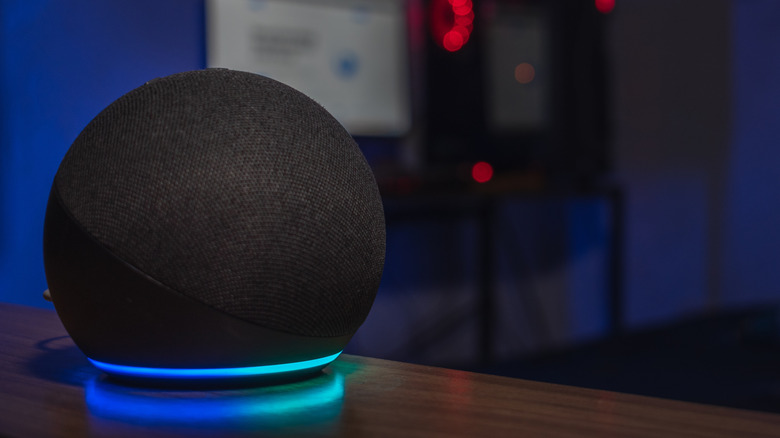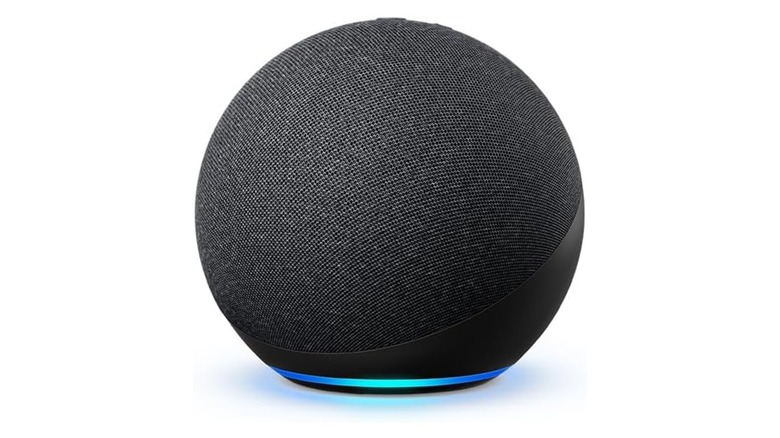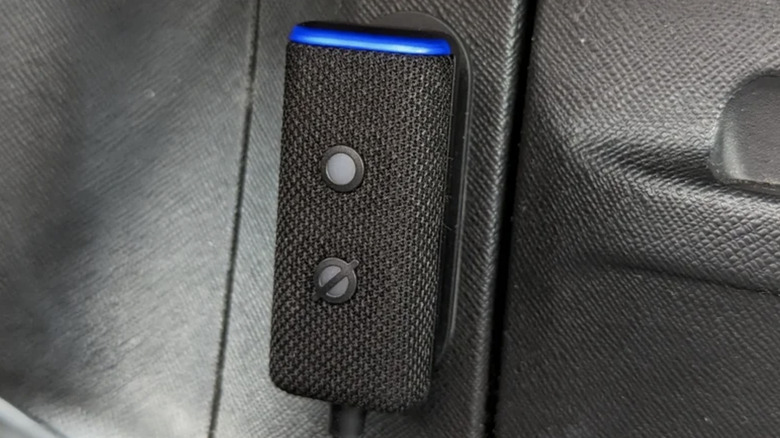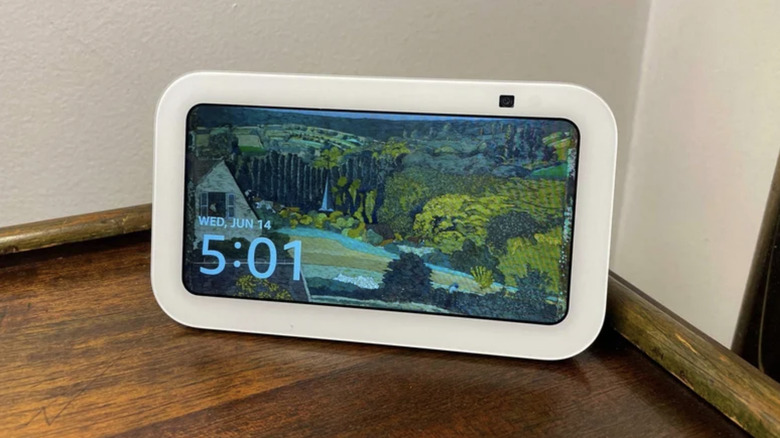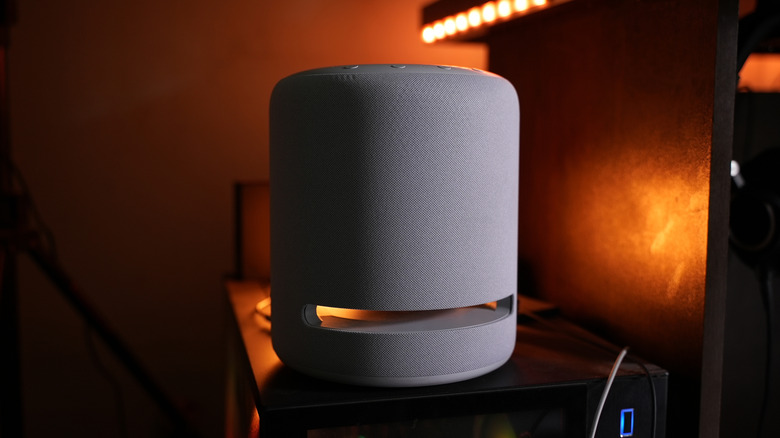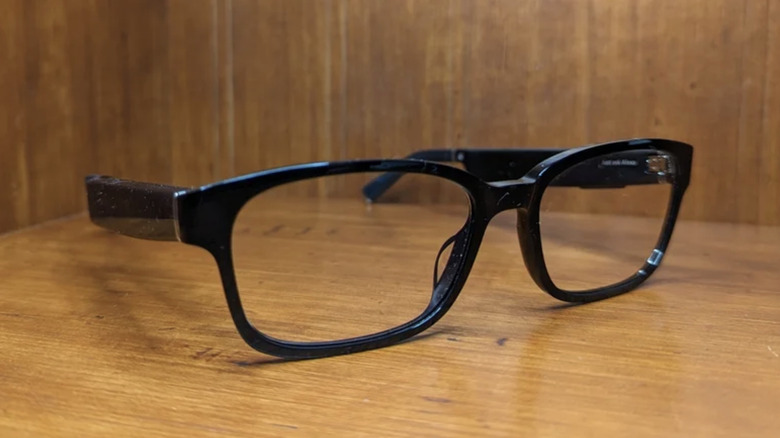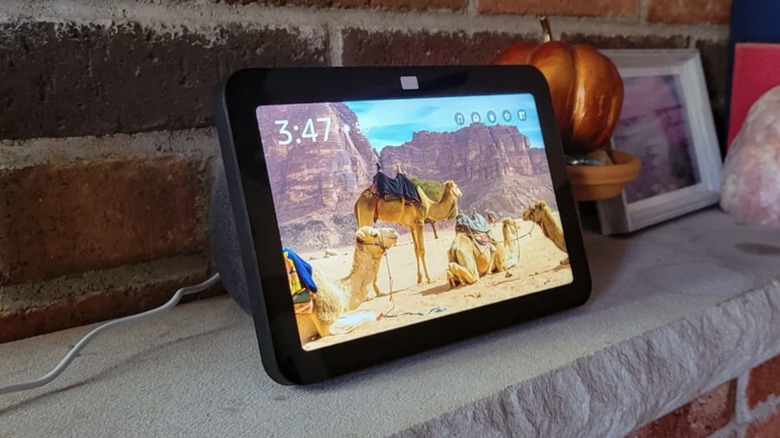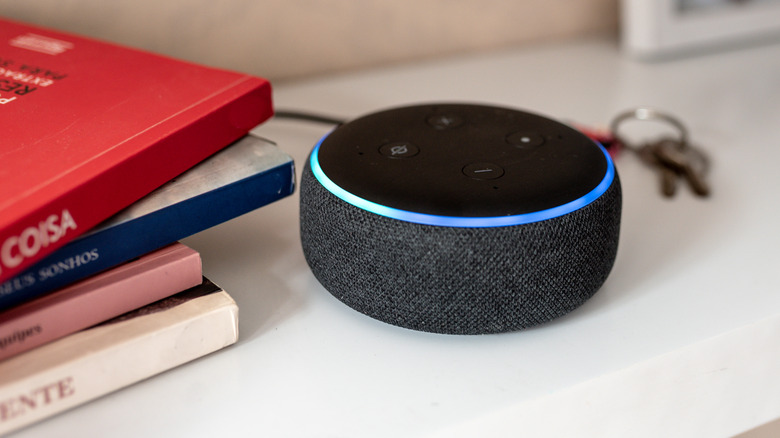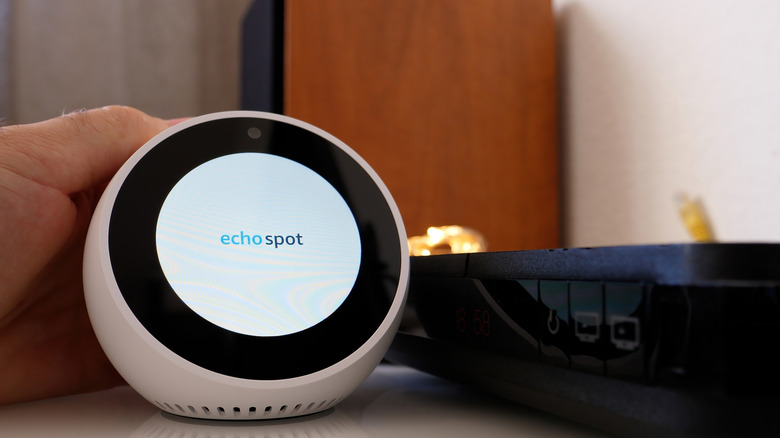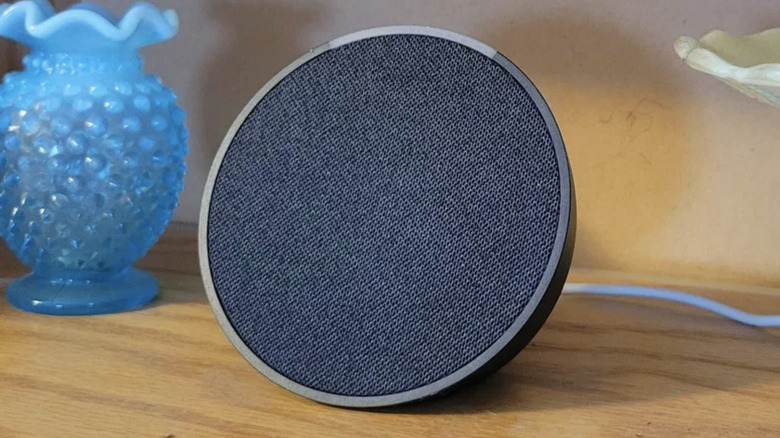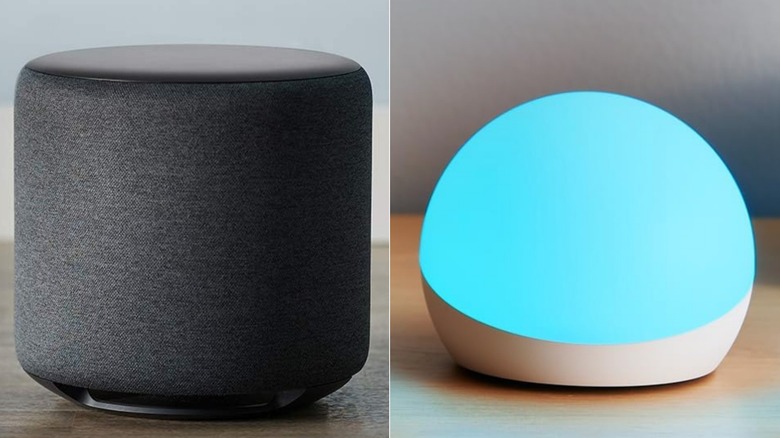Amazon Echo Guide: Which Device Is Right For You?
We may receive a commission on purchases made from links.
The Echo is one of Amazon's most iconic items. This smart speaker comes built-in with the company's Alexa assistant, providing similar assistance to modern artificial intelligence programs — even before the big AI boom of recent years. It is also far more capable than it might at first appear. Indeed, there are likely many things you never knew your Amazon Echo device could do, even if you happen to already own one. If you don't have one right now, though, you may have some difficulty deciding which version is the best for you.
There are multiple different iterations of the Echo, with some of them reaching beyond the smart speaker style to provide full visual displays. There are also some additional accessories with the "Echo" name in them, but they lack the ability to use Alexa on their own. Perhaps the greatest appeal of these devices is how they can seamlessly transform your average home into a smart one. Even so, depending on the model you have, responding to your questions is far from the only thing your Echo can do. Let's dive in and discover which Amazon Echo device is most suitable for you.
Echo
The basic Amazon Echo has previously been available in more cylindrical shapes, but the modern design is closer to a sphere. The newer version has quite a few more features as well, including a temperature sensor and built-in smart home hub, all offered at a base price of $99.99. The built-in hub and the compatibility with eero Wi-Fi are the biggest non-physical features separating this version of the Echo from cheaper alternatives like the Dot or Pop. The basic functionality of the device doesn't change much between each version, as all allow you to connect online and use Alexa across as many supported devices as possible.
However, the greatest draw of the basic Echo, compared to its alternatives, is how it functions as a speaker. While it doesn't go all-in on sound quality, it is still capable of filling an entire room with great audio. This is the primary use of the base Echo, which takes full advantage of its speaker capabilities when utilizing Alexa or playing lossless music. Of course, there are better options if you are solely concerned about the audio quality, but the additional features make the basic Echo one of the most advanced options in Amazon's lineup.
Echo Auto
The Amazon Echo Auto might be the smallest Echo device available, at least if you ignore its wired connection. As the name implies, this model is designed to fit inside your vehicle with ease, offering Alexa capabilities on the go without needing to lift a finger. While it obviously isn't as feature-complete or high-quality as the basic Echo, the Auto still manages to house all the essential "smart" functions found in the original. It can even connect to the other smart devices in your home from a distance, allowing you to stay connected no matter where you go.
However, the Echo Auto has some unfortunate quirks that can ruin its appeal in the eyes of some prospective buyers. Our Amazon Echo Auto (2nd Gen) review noted how unnecessary it is for anyone with newer cars and highlighted some of its connectivity issues when it comes to communicating with your car's audio system. If you want to always have access to Alexa and Amazon's services at all times, the Auto is still a decent choice. Even better, it's relatively inexpensive at just $54.99; just be prepared to spend quite a bit of time setting it up.
Echo Show
One of the most expensive Echo devices available is the Echo Show, and, considering its impressive features, it's not difficult to see why. Rather than merely being a smart speaker, the Show offers its own digital display alongside a camera for video calls and photos. The model varies in size and cost, with the smaller Echo Show 5 measuring in at 5 inches wide and priced at $89.99. These reductions don't diminish its quality too much, as our Amazon Echo Show 5 (3rd Gen, 2023) review still praised the device for its crisp visuals and fantastic audio.
There are other versions of the Echo Show as well. The Show 5 also has a kid-friendly model, Echo Show 5 Kids, that includes a year of Amazon's Kids+ service as well, and the larger Show 21 serves as the flagship variant of the device with a 21-inch display. The latter model takes things a step further by including Fire TV, which provides an easy way to watch your favorite shows, thus driving the price to $399.99. At $149.99, the Echo Show 8 falls between the other two models, featuring a better camera than the Show 5 but fewer features than the 21-inch version. If you decide to purchase an Echo Show, there are plenty of options to choose from before finalizing your decision.
Echo Studio
Although it's twice as expensive as the basic Echo model at $199.99, the Amazon Echo Studio does not offer quite as many features. It lacks any motion detection or temperature sensors, and there's no sort of display to go with it. The primary reason for this product's existence is for the audiophiles out there who still desire Alexa functionality. The Studio is designed with multiple speakers and tweeters already built in, along with a subwoofer, providing unparalleled audio quality compared to all other Echo devices available today.
Our list of major speaker brands ranked worst to best also highlighted the Echo Studio due to its exceptional sound quality. The device is marketed as Amazon's best-sounding smart speaker overall, standing above the other Echo products, even though this one was released all the way back in 2019. While it may not be up to par with other smart speakers, its connectivity with Alexa makes it an easy choice if you are already immersed in Amazon's smart home ecosystem.
Echo Frames & Echo Buds
Lacking the size of Amazon's other high-end products in this lineup, the Echo Frames take the form of audio glasses rather than a traditional speaker. Like other audio-based glasses, these spectacles are primarily meant for listening to music. However, the onboard Alexa assistant allows you to perform plenty of "smart" tasks on the go — just like with the Auto. Still, it's the price that makes this device a hard sell. It can be priced either as low as $269.99 or as high as $389.99, depending on which model you purchase. Our Amazon Echo Frames (3rd Gen) review also lamented its poor sound quality and lack of additional features, which makes this product seem a bit bare-bones compared to other options.
Alternatively, you could abandon the frames entirely in favor of Echo Buds, which offer the same set of features for a fraction of the cost. While they won't be helpful as a replacement for prescription glasses — obviously, since they're earbuds — the base cost of only $49.99 betrays how great they are in terms of sound quality (and Alexa functionality). You can also purchase Echo Buds with Active Noise Cancellation, but those cost a bit extra, pricing in at $119.99 for the additional feature. Both the Buds and the Frames are most attractive as Alexa-enabled alternatives to regular earbuds or glasses, but they probably shouldn't be your first choice if you are looking for something more substantial.
Echo Hub
Although it might seem similar to the Echo Show at first, the Echo Hub has a very different purpose. Once you understand everything you need to know to get started with Amazon's Echo Hub, you will see just how many of its functions are dedicated to smart home control. Compared to the Show, it focuses on more advanced control over as many devices as it can find, providing a touchscreen interface to let you access them all from one area. Of course, it also features a built-in Alexa assistant, so you can still make use of it even if you don't have any other pieces of smart technology at home.
Of course, some sacrifices are made compared to the Show. The Echo Hub comes in only one variant, boasting a size of just 8 inches and a price of $179.99. It also eliminates the Show's camera, forcing you to use a different device if you want to make use of video calling. The Echo Hub can easily justify its price when used alongside other Alexa-compatible devices, but its overall value becomes a bit less defensible on its own.
Echo Dot
At half the price — and nearly half the size — of the basic Echo, the Amazon Echo Dot is a very appealing choice for a first-time smart device. It's inexpensive, at $49.99, and is an excellent speaker on its own. However, you miss out on the superior sound quality and lose access to the built-in Zigbee Smart Home Hub, which could enhance connectivity with non-Amazon devices. While this limits the Dot's capabilities in a larger smart home environment, it retains all the other features of the basic Echo. The less-impressive audio may not matter as much if you place the Dot in a smaller space, such as a bedroom.
Like the Echo Show, there is also an Echo Dot Kids. This version of the Dot features more playful designs and a year of the aforementioned Kids+ subscription, though it does cost $10 more than the basic Dot. It's not too difficult to figure out how to set up your Amazon Echo Dot, either, which may be another reason someone might lean toward this device. It may lack the specialization of other models, but this particular Echo offers of the best value of the lineup.
Echo Spot
The Echo Spot costs $79.99, falling between the Dot and base Echo in terms of price — but not in terms of features. In fact, this Echo loses out on quite a few functions offered by both of those models, including the temperature sensor and the built-in eero. The Spot makes up for this by being one of the few Echo devices to include a screen, though it offers more basic functionality compared to the similar Echo Show. This device is meant to be used like an alarm clock, albeit one that retains the Alexa functionality present in other Echo devices.
Interestingly, Amazon discontinued the Echo Spot in 2019 before bringing it back in 2024. Considering all the different options offered by Amazon today, it may seem redundant to purchase the Spot when the Show 5 is only $10 more, but the former's more compact size and dedicated use give it a fine niche. Plus, it happens to lack the same level of intrusive advertisements, which has led to some users to switch away from the Show in favor of this model.
Echo Pop
The cheapest Echo model you can buy today is the Echo Pop, priced at $39.99 for the basic version and $49.99 for the Echo Pop Kids model. To keep its price as low as possible, this device strips away almost every non-Alexa feature, retaining only the built-in eero compatibility. It is also the smallest Echo of the bunch, so if you really don't have any free space to spare, this may be the best option for you. However, the extra $10 for an Echo Dot will give you a lot more bang for your buck, making the Pop only truly suitable for the tightest budgets.
Just like the Dot, the Pop Kids has a slightly different look featuring various colorful characters, including many from Disney franchises. However, you only get 6 months of Amazon's Kids+ subscription rather than a full year, which harms its value even more when compared to other Echo devices. Still, the Pop isn't bad on its own. You certainly won't find a cheaper alternative if all you care about is using Alexa. It just doesn't quite measure up compared to its counterparts, even when considering the price differences.
Echo Sub & Echo Glow
The Amazon Echo Sub and Amazon Echo Glow are a pair of useful devices that might end up being overlooked. The Sub, priced at $129.99, is a subwoofer designed to add powerful bass to your music. Meanwhile, the Glow is priced at the especially low cost of just $29.99 and is a smart lamp intended to provide colorful and gentle illumination to any environment. Both perform as well as they can at their price point, but they come with a pretty big catch.
Both the Sub and the Glow aren't technically Echo devices. While they can boast the same Alexa functionality — on top of sharing the same naming scheme — they can only utilize that functionality after being connected to a more capable Echo device. Unlike everything else in this list, neither of these devices can be used on their own, making them more like accessories than traditional Echo devices. They are easy to consider after you already have another existing Echo, but you shouldn't purchase either of these on their own and expect a response after speaking to them.
